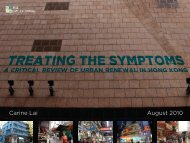Untitled - Civic Exchange
Untitled - Civic Exchange
Untitled - Civic Exchange
You also want an ePaper? Increase the reach of your titles
YUMPU automatically turns print PDFs into web optimized ePapers that Google loves.
Chapter 3:<br />
Road versus Rail - Financing Mass Transit in Hong Kong<br />
Figure 3.5<br />
Tokyo urban rail system (Japan)<br />
Source: <br />
Until recently, the government's policy was that rail infrastructure would be put in place only after<br />
population levels were sufficient to allow system extensions to be quickly self-financing. Tseung Kwan O,<br />
for example, had to wait a decade for rail service, even though it lies only 3 km from an existing rail line.<br />
Even today, financing policy is modified only occasionally and on an ad hoc basis, as with the creation of<br />
the West Rail System to accommodate anticipated major population increases in the Western New<br />
Territories. In the case of the Northwest New Territories, mobility and air quality problems necessitated the<br />
early provision of clean, rail-based mass transit. Had the traditional policy been applied and area residents<br />
forced to wait until population levels had increased massively, there would likely have been traffic chaos<br />
and very severe episodes of air pollution. Failure to prevent these kinds of outcomes could damage the<br />
HKSAR's image internationally, in addition to jeopardizing the quality of life available to Hong Kong<br />
people.<br />
Bus-rail coordination<br />
In contrast to the skeletal coverage of rail in Hong Kong, buses provide extensive coverage in less densely<br />
populated areas. Further, bus fleets often compete directly with passenger rail, tending to raise costs for<br />
both providers. 68 The government's requirement that rail providers recover both capital and operating costs<br />
68<br />
While economists generally mistrust terms like wasteful competition (seeing them as "code words" for a hidden<br />
agenda), under specific conditions competition can be inefficient because it tends to increase, rather than lower, the<br />
overall costs of service. For example, inefficient bus-rail competition results in two basic problems. Consider a<br />
long-haul passenger transport route where road transport alone cannot adequately meet demand, but rail service<br />
could meet demand alone or with supplemental bus service. Here, the addition of large-scale direct bus<br />
competition for an existing fixed rail route reduces rail load factors, while the rail option keeps bus load factors<br />
low. This raises the average cost of service to both transport providers beyond what it would be if service by one<br />
major provider was supplemented with service from another provider. When buses are subsidized (or crosssubsidized<br />
through particular government policies), they may be able to operate on these routes at a modest profit,<br />
even with low load factors. Meanwhile, the rail provider must continue to operate so long as it takes in any income<br />
above its operating expenses so as to be able to repay the high fixed cost of railway construction<br />
25

















